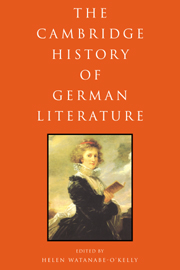Book contents
- Frontmatter
- 1 The Carolingian period and the early Middle Ages (750–1100)
- 2 The high and later Middle Ages (1100–1450)
- 3 The early modern period (1450–1720)
- 4 The German Enlightenment (1720–1790)
- 5 Aesthetic humanism (1790–1830)
- 6 Revolution, resignation, realism (1830–1890)
- 7 From Naturalism to National Socialism (1890–1945)
- 8 The literature of the German Democratic Republic (1945–1990)
- 9 German writing in the West (1945–1990)
- Select bibliography
- Index
- References
3 - The early modern period (1450–1720)
Published online by Cambridge University Press: 28 March 2008
- Frontmatter
- 1 The Carolingian period and the early Middle Ages (750–1100)
- 2 The high and later Middle Ages (1100–1450)
- 3 The early modern period (1450–1720)
- 4 The German Enlightenment (1720–1790)
- 5 Aesthetic humanism (1790–1830)
- 6 Revolution, resignation, realism (1830–1890)
- 7 From Naturalism to National Socialism (1890–1945)
- 8 The literature of the German Democratic Republic (1945–1990)
- 9 German writing in the West (1945–1990)
- Select bibliography
- Index
- References
Summary
This period, which begins before the Reformation and ends with the dawning of the Enlightenment, laid down the foundations of the thought and writing of the modern age and determined the future course of the German-speaking world. Germany in the modern sense did not yet exist, so the territory under discussion is the Holy Roman Empire. We must also remember that in this period most writers moved at will between Latin and German. Not until 1681 do the catalogues for the German book fairs show that more books were being published in German than in Latin.
Books and writers before the Reformation
Around 1445 in Mainz, Johann Gensfleisch (c. 1400–68), better known as Gutenberg, succeeded in printing with movable metal type. He also used paper, invented in the twelfth century, but only readily available in Germany in the fifteenth. Manuscript and print survived side by side and the boundaries between them remained blurred for a long time. Scriptoria producing multiple copies of manuscripts for sale already existed in the fifteenth century, anticipating the mass-production of the printing press, while books in the early decades were so costly as to constitute luxury items on a par with manuscripts. Books were printed on parchment and manuscripts written on paper. Many early printed books were designed to look like manuscripts, while the manuscript itself survived as a prestige tailormade item for rich, usually courtly patrons. But the book as commodity had come into being and it is no accident that the early centres of printing and publishing were important commercial towns on international trade routes: Mainz, Strasbourg, Basle, Nuremberg, Augsburg, Ulm, Cologne and Leipzig.
- Type
- Chapter
- Information
- The Cambridge History of German Literature , pp. 92 - 146Publisher: Cambridge University PressPrint publication year: 1997



